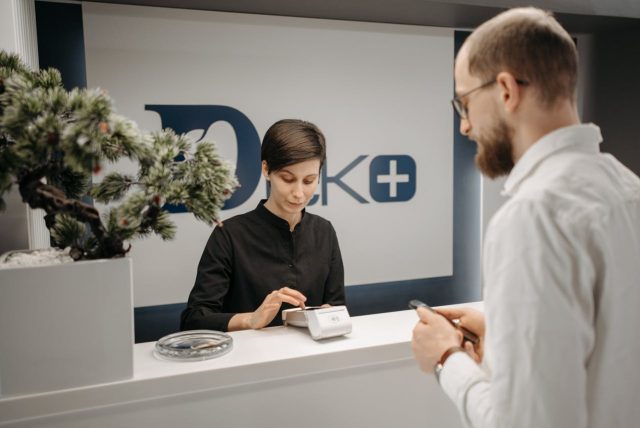Healthcare payments have become increasingly complex. Managing payments today comes with challenges such as:
- Complexity and fragmentation: The payment process involves many distinct areas—patients, insurers, healthcare providers, and revenue cycle management (RCM) companies —resulting in a dispersed and labor-intensive system.
- Data security and compliance: Safeguarding sensitive health and payment data under strict regulations.
- Billing errors and denials: Increasing paperwork errors that delay payments.
These challenges lead to operational hurdles, higher tangible and intangible costs, and unsatisfied patients.
As patient expectations for seamless transactions grow, healthcare organizations relying on outdated manual payment systems like paper checks risk falling behind.
Healthcare payment automation offers a solution—delivering faster, more efficient payments while reducing administrative headaches.
At Dash Solutions, we’ve been in the payments industry for 27 years, helping healthcare organizations streamline refunds and disbursements. We deliver simplified, digital-first payment solutions that provide a secure, compliant, and cost-effective alternative to traditional check-based payments.
Simplify Healthcare Payments with Automation
In this blog post, you will learn about:
- The common (and curable) friction points in delivering patient payments.
- The easily avoidable traps that are often missed.
- And, how choice, speed, and context can be leveraged to improve your patient experience (while reducing your administrative cost).
What is Healthcare Payment Automation
Healthcare payment automation means using digital tools to make payment processes in the healthcare industry smoother.
When patients pay for care, the goal is simplicity, but when you have to pay them, are you making it an equally simple experience?
By automating outbound payments, organizations don’t just reduce administrative burdens and cut costs, but also improve the patient experience–a key way to increase patient footfall and increase revenue.
Digital-first solutions benefits:
- Large hospital networks
- Emergency care clinics
- Health insurance providers
- Dental offices
- Revenue cycle management providers
State of Healthcare Payment Automation in 2025
Think about the last time a payment delay caused frustration in your organization. Was it a patient waiting for a refund? A plethora of customer service calls regarding the payment?
While industries like retail and finance have made seamless digital payments the norm, healthcare remains stuck in a manual-heavy system that bleeds both time and revenue.
This results in slower reimbursements, delayed patient payments, and unnecessary labor costs that put healthcare organizations at a competitive disadvantage.
Many healthcare providers use old, manual systems for both receiving and sending payments.
Patients today expect the same convenience in healthcare payments as they do when shopping online.
Payment automation offers a way forward. It enables faster transactions, reduces errors and streamlines financial operations to keep up with evolving patient expectations.
According to PYMNTS, in 2023, only 39% of patients preferred instant healthcare disbursements, but by 2024, that number had nearly doubled to 77%. This sharp rise highlights the growing demand for quicker, more transparent financial transactions in healthcare.
If your payment system still relies on checks and paper forms, you’re not just dealing with inefficiencies—you’re risking patient loyalty and revenue loss.
Healthcare executives are taking advantage of automation and investing in it at scale.
Grant Thornton’s survey showed that 71% of healthcare executives are prioritizing automation as a cost-reduction strategy. They recognize that labor-intensive finance operations are unsustainable.
For CFOs, this means a shift from reactive cost-cutting to proactive financial transformation.
READ MORE: Maximizing Productivity in Healthcare Workforce
Benefits of Healthcare Payment Automation
The impact of healthcare payments automation extends beyond just faster transactions. Let’s break down the most significant benefits and why CFOs and CROs should prioritize automation.
Cut Transaction Costs
Every manual payment comes with higher fees.
Digitizing the payments cuts the material costs of delivering that consumer payment via paper, which includes the cost of paper and postage.

On average, processing a paper check costs over $7, while electronic payments cost around $4—saving $3 per transaction.
The cost difference might be small, until you scale it. For healthcare organizations processing hundreds of thousands of payments annually, that’s millions of dollars lost in inefficiencies. By transitioning to automated payments, you free up capital that could be reinvested into patient care, technology, or growth initiatives.
Cut Labor Costs
Manual payment processing is often slow and expensive. It often includes:
- Data entry for each outgoing check payment
- Verification and reconciliation to confirm payee details and amounts
- Error handling to correcting manual entry mistakes
- Administrative overhead per payment for reviews, approvals, and documentation
- Frequent bank trips
There are also indirect costs incurred on training, supervision, and auditing.
Not only that, paper checks have many other one-off manual tasks involved, such as:
- Placing a stop-payment on any lost checks and reissuing new ones
- Looking into and managing returned or bounced checks
Automating payments eliminates these manual tasks, reducing payroll hours spent on administration.
Reduce Errors
Digital payments also minimize the occurrence of errors often seen in manual processing, such as:
- Duplicate checks
- Incorrect payment details
- Missing or improper signatures
Reducing errors is crucial because they can lead to delayed or denied reimbursements, increased administrative costs, compliance issues, and patient dissatisfaction.
Automating healthcare disbursements reduces human errors by eliminating manual data entry and standardizing processes.
It ensures consistent data handling and automatically flags discrepancies. This accelerates payment verification, ultimately reducing claim rejections and enhancing patient relationships.
Streamline Your Healthcare Payments Today
Improve Patient Experience
Patients expect fast and seamless financial interactions, just like they experience in retail and banking.
For example, Grant Thorton’s survey of healthcare CFOs found that improving patient experience is their top growth priority, outranking expansion and new service launches.
When patients face long refund delays, they get frustrated and often reconsider where they get their care. A seamless payment experience offers convenience.
It’s a direct driver of patient retention and revenue growth. If you want to increase patient footfall, it starts with frictionless financial interactions.
Patient satisfaction is also a key factor in financial incentives, with HCAHPS (Hospital Consumer Assessment of Healthcare Providers and Systems) scores playing a critical role in determining government funding received by healthcare organizations.
This is driving healthcare leaders to find ways to improve their ratings and enhance overall patient experiences.
Reduce Customer Service Responsibilities
Payment issues are one of the biggest reasons patients contact customer service. However, with automated payments, the volume of inquiries drops significantly. Fewer delays, clearer billing and instant refunds mean fewer patient complaints.
Your finance and customer service teams shouldn’t be spending hours on payment disputes. But when patients face delays, errors, or unclear bills, their first call is usually to your staff.
Every manual issue creates more work, increases labor costs, and frustrates both patients and employees. By automating payments, you reduce call volumes, free up staff time for higher-value work and improve the overall patient experience.
Even when inquiries arise, API-based healthcare payments automation ensures every transaction is tracked and accessible at the click of a button and providers can quickly verify payment details.
Avoid Escheatment Hassles
Unclaimed payments create compliance nightmares. Custodial unclaimed property responsibilities refer to managing and safeguarding assets that have been abandoned or unclaimed by their owners.
Without automated tracking and reporting, funds can be subject to state-by-state escheatment laws, adding regulatory burdens. Escheatment laws require that custodians transfer unclaimed property to the state after a specified period.
Healthcare organizations already face complex regulatory challenges. Automated payments tracking ensures you stay compliant, reduce risk, and avoid costly penalties.
It also ensures patients get their funds quickly, keeping your organization out of the tricky rules about unclaimed property.
Optimize Transactions for Better Care
Types of Healthcare Payments
To maximize performance, you should automate all outbound payments. Let’s explore the key areas for automating healthcare disbursements:
Patient Refunds
Healthcare organizations issue patient refunds when overpayments occur due to:
- Insurance adjustments
- Billing errors
- Upfront payments exceeding actual costs
Refunds are a frequent part of the revenue cycle, making efficient processing essential.
With prepaid cards, providers can issue refunds quickly and securely, improving the patient experience with a flexible financial instrument.
Medical Loss Ratio Rebate Payments
Under the Affordable Care Act, health insurance providers must issue Medical Loss Ratio (MLR) rebates when they don’t spend enough premium revenue on patient care and quality improvements.
These rebates are typically issued annually and impact millions of policyholders, which makes timely processing important.
Automation ensures timely reimbursements while maintaining compliance by accurately tracking payments and meeting regulatory deadlines.
Rewarding Patients
Engaging patients through financial incentives can encourage healthier behaviors. Automated rewards can be used for wellness programs, timely appointment attendance, or adherence to treatment plans.
When healthcare organizations leverage automation, rewarding patients becomes optimized and impactful.
How to Automate Healthcare Payments
Automating healthcare payments can be simple if you have the right partner. Working with a digital partner that focuses on payment automation leads to smooth, secure, and efficient transactions.
Dash Solutions makes healthcare payments easier. Our innovative solutions cut out manual work and lessen admin tasks.
We facilitate fast and secure fund disbursement while complying with standards such as HIPAA, NACHA, and PCI-DSS. This helps to ensure your payments are handled with the highest level of security.
Not ready to fully make the shift to direct-to-account disbursements? No problem. We offer customizable plastic cards for organizations that still want a flexible alternative.
For added convenience, our SpendIT SendIT solution lets recipients transfer funds easily to Venmo, PayPal, or other payout options. You get quicker payouts, happier patients, members, and employees, and a smoother financial process.
Transform Healthcare Payments with Automation
Frequently Asked Questions
What to look for in a healthcare payment automation software?
Focus on efficiency, security, flexibility, transparency, and compliance. This will help ensure smooth transactions, offer adaptable solution, and prevent fraud.
Is healthcare payment automations secure?
If you choose the right solution, healthcare payment automation is secure. Top solutions meet strict compliance standards such as HIPAA, PCI-DSS, and NACHA. This ensures secure transactions and robust data protection.
Contact us to explore how we can support your goals for higher-quality services and long-term growth.


